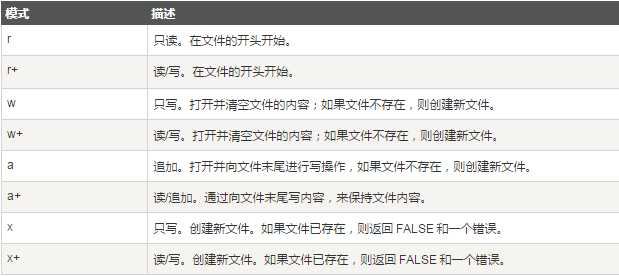PHP file handling
PHP File Processing
Data Access
There are two main ways to access data on the server: File or database
Currently, most applications use databases to read and write data, but file access is still used in some situations, such as:
• Recording error logs
• Export data to file
Import data from file
Write file
There are three main steps to write a file, just like we do manually In the same way, the program must follow the following steps:
• Open the file, use the FOPEN function
• Write the file, use the fwrite function
• Close the file, use the FCLOSE function
Open File
fopen() function is used to open a file in PHP.
The first parameter of this function contains the name of the file to be opened, and the second parameter specifies which mode to use to open the file:
<html>
<body>
<?php
$file=fopen("welcome.txt","r");
?>
</body>
</html>The file may be opened in the following modes:

Note: If the fopen() function cannot open the specified file, it returns 0 (false).
Example
If the fopen() function cannot open the specified file, the following example will generate a message:
<html>
<body>
<?php
$file=fopen("welcome.txt","r") or exit("Unable to open file!");
?>
</body>
</html>Write file
fwrite () function is used to write files
fwrite also has two main parameters. handle is the Resource variable returned after fopen is opened successfully, and string is the data to be written
int fwrite ( resource $handle , string $string [, int $length ] )
When the writing is successful, fwrite will return the number of characters written. If the writing fails, it will return false
Example
<?php
$myfile = fopen("newfile.txt", "w") or die("Unable to open file!");
$txt = "Bill Gates\n";
fwrite($myfile, $txt);
$txt = "Steve Jobs\n";
fwrite($myfile, $txt);
fclose($myfile);
?>Please note that we wrote to the file "newfile.txt" twice. Each time we write to the file, the string $txt we send contains "Bill Gates" the first time and "Steve Jobs" the second time. After writing is complete, we use the fclose() function to close the file.
If we open the "newfile.txt" file, it should look like this:
Bill Gates
Steve Jobs
Read the file
fread is used to read the entire file without using a while statement to loop. It should be noted that the second parameter is used to control the maximum number of bytes read. This parameter is required.
string fread (resource $handle, int $length)
Execution
echo fread($resource, 1024);
Can read up to 1024 Bytes of file content
Close the file
fclose() function is used to close the open file:
<?php
$file = fopen("test.txt","r");
//执行一些代码
fclose($file);
?>Detect the end of the file (EOF)
feof() function detects whether the end of file (EOF) has been reached.
The feof() function is useful when looping through data of unknown length.
Note: In w , a and x modes, you cannot read open files!
if (feof($file)) echo "End of file";
Read the file line by line
fgets() function is used to read from Read the file line by line from the file.
Note: After calling this function, the file pointer will move to the next line.
Example
The following example reads a file line by line until the end of the file:
<?php
$file = fopen("welcome.txt", "r") or exit("无法打开文件!");
// 读取文件每一行,直到文件结尾
while(!feof($file))
{
echo fgets($file). "<br>";
}
fclose($file);
?>Reads the file character by character
## The #fgetc() function is used to read from a file character by character. Note: After calling this function, the file pointer will move to the next character. ExampleThe following example reads the file character by character until the end of the file:<?php
$file=fopen("welcome.txt","r") or exit("无法打开文件!");
while (!feof($file))
{
echo fgetc($file);
}
fclose($file);
?>file_put_contents
Whether Whether reading or writing, fopen and fclose are very cumbersome calls. Starting from PHP5, a new function int file_put_contents ( string $filename , mixed $data [, int $flags = 0 [, resource $ context ]] )file_put_contents is equivalent to executing fopen + fwrite + fclosefile_put_contents('file', "hello world\n");file_put_contents('file ', "hello world\n", FILE_APPEND);file_get_contents
string file_get_contents ( string $filename [, bool $use_include_path = false [, resource$context [ , int $offset = -1 [, int $maxlen ]]]] ) file_get_contents is equivalent to executing fopen + fread + fcloseecho file_get_contents('file');
Other file operation functions
S file_exists passes the file address as a parameter to determine whether the file exists, and then true or falseS filesize can return the parameter The size of the file in bytesS unlink can delete the file represented by the file address passed to it